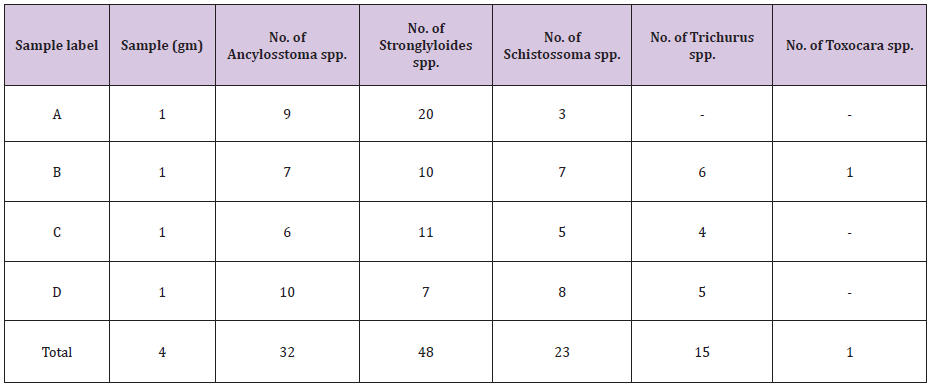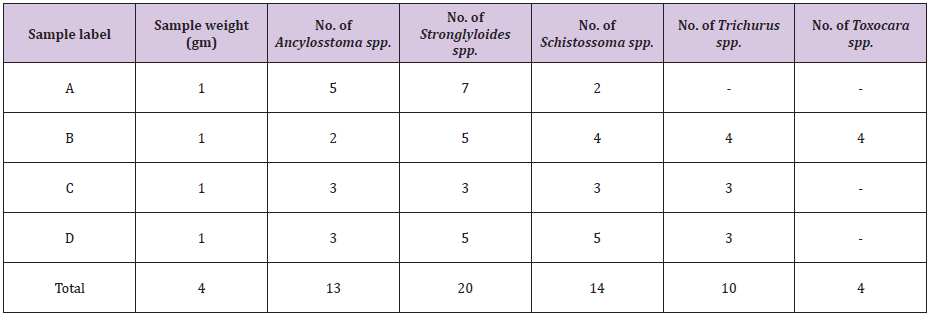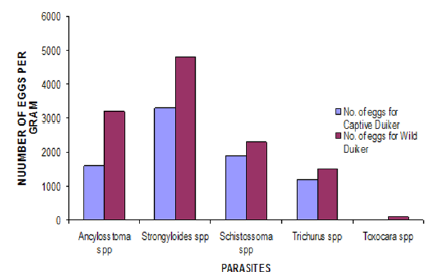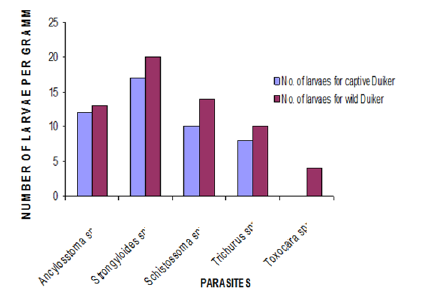Impact Factor : 0.548
- NLM ID: 101723284
- OCoLC: 999826537
- LCCN: 2017202541
*Adelakun KM, Halidu SK, Ogialekhe P, Omole EB and Akinade TG
Received: July 28, 2017; Published: August 14, 2017
Corresponding author: Adelakun KM, Federal College of Wildlife Management. P.M.B.268, New Bussa, Nigeria
DOI: 10.26717/BJSTR.2017.01.000270
Based on the recent intensify movement to domesticate and farm wild small ruminant animals in this environment, a study was carried out to examine endoparasite present in faecal dropping of grey duiker (Sylvicapra grimmia) both in the wild and captivity in Kainji Lake National Park and Federal College of Wildlife Management Mini-Zoo, New Bussa, respectively. The result revealed the type of endoparasites found in the sample, as well as number of eggs and larva. Endoparasites identified include: Threadworm (Stronglyloides papillosus.), Hookworm (Ancylosstoma duodenale), Whipworm (Trichurus globulosa), Blood fluke worm (Schistossoma spindalis) which are found in both animals faecal samples while Large intestinal roundworm (Toxocara vitulorum) was found only in wild grey duiker sample. Threadworm (Stronglyloides spp.) had the highest number of eggs per gram 4, 800 (40.34%) for wild duiker, while 3,300 (41.25%) for captive duiker with 20 and 17 larva for wild duiker and captive duiker respectively. The Hookworm (Ancylosstoma duodenale), have 3,200 (26.89%) eggs per gram for wild duiker and 1,600 (20.0%) for captive duiker while 13 and 12 larva were counted for wild and captive. The Whipworm (Trichuris spp.) had the lowest number of eggs per gram 1,500 (12.60%) for wild duiker while 1,200 (15.0%) for captive duiker and the number of species had the wild duiker and 8 for captive duiker. Schistossoma spp. have the lowest number of eggs per gram 2,300 (19.33%) for the wild duiker, 1,900 (23.75%) for captive duiker with 14 larva for wild duiker and 10 for captive duiker while Large intestine round worm (Toxocara vitulorum) present in wild duiker only with 100eggs (0.84%) and 4 larva. Proper managements should be the priority of all and sundry involved in wild animal domestication for the good health and productive indices of both animals especially as they continue to interact more often with other animals over a large area.
Keywords: Captive; Domestication; Endoparasite; Faecal; Wildlife
The grey duiker (Sylvicapra grimmia) is an important wild small ruminant animal found in wide variety of habitat in Sub - Saharan Africa and central Africa. It has becomes a very important animal for natural heritage and has real economic potential for many inhabitants, both in rural and urban centres in Nigeria. Because of this, attempts are being made by various interest groups and individuals to domesticate these small wild ruminants so as to exploit this wildlife resource as a source of animal’s protein and profits [1]. However, very little in know about its parasitic in health and how they may affects its exploitation potential in the wild and captivity, especially in disease or others stress conditions the faecal examination of endoparasite can be used to monitor and evaluate disease prognosis and determine the sustainability of wildlife populations for translocation, re-stocking, re – introduction or restoration for ecological programmes.
Endoparasites are the group of parasite that lives in different organism from which it derives nutrition or protection without benefiting the host, usually causing harms [2]. Parasite are widely spread in distribution and control have been studied as it was reported in most parts of Nigeria [3] and Africa sub – regions such as Zimbabwe, South Africa and Congo [4]. These endoparasites are in various sizes and shapes depending on the worm burden, all are pathogenic to animals [3]. Hookworm for example causes anaemia, stunted growth, neurological and other symptoms in animal, which can result to the death of animals if prolonged [5,6]. Examination of faecal sample of Western kob (Kobus kob) from Kainji Lake National Park by [7] revealed the presence of stomachworm (Haemonchus contortus), Ascaris spp and stronglyle ova. Similar incidents of hookworms were discovered when a postmortem was performed on a dead patas monkey (Erthrocepus patas). There is a need to acquire information on the endoparasites of grey duiker (Sylvicapra grimmia) in wild and captive that might assist in management practices of duiker.
The study areas of this project work comprises of two (2) places which are; Federal College of Wildlife Management Mini - Zoo and Borgu Sector of Kainji Lake National Park, New Bussa, Niger State.
Materials used are: Test tubes, centrifuged machine, microscope pestle and mortar, slides, weighing balance, water, feacal dropping and sugar solution.
Random sample of Duiker (Sylvicapra grimmia) Fresh faecal dropping were collected both from wild and in captivity at four different locations in Kainji Lake National Park and twice from two different duiker cages in Federal College of Wildlife Management Mini – Zoo respectively. These samples were immediately tagged and kept in a polythene bags. The samples were preserved in ice block at about 50C and taken to the laboratory for diagnosis analysis [8].
i. Concentration method: Adam et al. [9], this method enable detection of small numbers of endoparasite eggs and larvae through concentration by sedimentation. It is also ideal for eggs counting by concentration in a small volume as used by Stoll [10]. About 1gm of faecal droppings and 10ml of formalin were mixed together and stained with the aid of sieve directly into centrifuge tube, 3ml of other were dispensed into the filtrate. The mixture were thoroughly mixed using glass rod and centrifuged for period of 2 minutes. The supernatant of debris and formalin other were gently discarded remaining the sediments. The sediments were agitated to form suspension were transferred on clean slide and covered with slip and examined under low power microscope.
ii.Egg Counting Techniques: Eggs present in each sample were determined using Stoll dilution method. The specific number of eggs observed on each slide was multiplied by 100 to obtain total number of eggs per gram of each specimen, Stoll [10].
iii. Faecal Culture for larvae recovery: 0.5gm of each ample were routinely smeared on a strips of filler paper, their lower ends were dipped into test tube containing 2ml of distilled water. The top were covered with cotton wool and kept at 25°C for 7days. Thereafter, the cotton wool was removed and the filter paper pulled out of the distilled water. The hatched larvae water immobilized by the addition of a drop of iodine solution and examined under microscope. Effective larvae of endoparasites were identified based on the standard descriptions [11](Soulsby, 1982).
iv. Data Analysis: The data collected were analysed using descriptive statistical analysis of simple percentage and multiple bar charts.
The result have shown that both wild and captive duikers are infected with four types of endoparasites which are; Threadworm (Stronglyloides papillosus.), Hookworm (Ancylosstoma duodenale), Whipworm (Trichurus globulosa), Blood flukeworm (Schistossoma spindalis) as it was found in both animals faecal samples while Large intestinal roundworm (Toxocara vitulorum) was found only in wild grey duiker sample. Threadworm (Stronglyloides spp.) had the highest number of eggs per gram 4, 800 (40.34%) for wild duiker, while 3,300 (41.25%) for captive duiker with 20 and 17 larva for wild duiker and captive duiker respectively. The Hookworm (Ancylosstoma duodenale), have 3,200 (26.89%) eggs per gram for wild duiker and 1,600 (20.0%) for captive duiker while 13 and 12 larva were counted for wild and captive. The Whipworm (Trichuris spp.) had the lowest number of eggs per gram 1,500 (12.60%) for wild duiker while 1,200 (15.0%) for captive duiker and the number of species had the wild duiker and 8 for captive duiker. Schistossoma spp. have the lowest number of eggs per gram 2,300 (19.33%) for the wild duiker, 1,900 (23.75%) for captive duiker with 14 larva for wild duiker and 10 for captive duiker while Large intestine round worm (Toxocara vitulorum) present in wild duiker only with 100eggs (0.84%) and 4 larva (Tables 1-6) (Figures 1 & 2).
Table 1: Egg Counts In Wild Duiker Faecal Sample.

Table 2: Larva Counts In Wild Duiker Faecal Sample.

Table 3: Egg Counts In Captive Duiker Morning Faecal Sample.

Where: MA1 is fresh sample collected in the morning from duiker in the main enclosure.
MB1 is fresh sample collected in the morning from duiker in the mini cage.
Table 4:Egg Counts In Captive Duiker Evening Faecal Sample.

Where: EA2 is fresh sample collected in the evening from duiker in the main enclosure.
EB2 is fresh sample collected in the evening from duiker in the mini cage.
Table 5:Larva Counts In Captive Duiker Morning Faecal Sample.

Where: MA1 is fresh sample collected in the morning from duiker in the main enclosure.
MB1 is fresh sample collected in the morning from duiker in the mini cage.
Table 6:Larva Counts In Captive Duiker Morning Faecal Sample.

Where: EA2 is fresh sample collected in the evening from duiker in the main enclosure.
EB2 is fresh sample collected in the evening from duiker in the mini cage
Figure 1: A Bar Chart Showing the total numbers of eggs per grams of Endo parasites observed in both study area.

Figure 2: A Bar Chart Showing the total numbers of eggs per grams of Endo parasites observed in both study area.

The results of this project work indicate that the numbers of EPG (i.e. Eggs per gram) and larvae of endoparasite in the wild duiker is much more compared to those in captivity. This may be due to several reasons such as interaction with another species in wild; feeding in different varieties of plants in the wild and the level of management which are differ for those in captivity. The microscopic examination reveals that the eggs observed in wild grey duiker were bigger than that of those in captivity. Different observation in types and number of eggs in endoparasite may be as a result of interaction with another species in the wild, climatic condition of the wild and management techniques involved in protected area which is very low compared with captivity [12-16].
The result of this project shows that both wild and captive grey duiker have infectious endoparasites, which can result to ill health of the animals, it is then suggested that animal be treated with antelmintic during translocation but should remain in isolation throughout the period of treatment. Some plants have establish to have natural curative value especially in the area of natural medicine, it is then suggested that more research should be done on plants that have medicinal value, especially those that have anti – biotic effect, so as to introduce such plant in the diet of captive duiker. During either restoration or re- introduction, animals are exported from one region to another; proper quarantine of such animal(s) in order to avert any transmissible disease will be of great importance. Early monitoring is essential to the health and productive indices of animals especially as they continue to interact more often with other animals over a large area, it is recommended that proper management should be priority of all and sundry involve in wild animal domestication.


